PATENT™ SYMBIONIC TEETH
SCIENCE AT THE CORE
SCIENCE AT THE CORE
BACKED BY SCIENCE
CLINICALLY VALIDATED
The Patent™ Symbionic Teeth System is built on a foundation of rigorous science and ongoing clinical research. Every critical aspect of its design, material, and surface has been carefully studied, and all claims are supported by evidence.
Combined with a 20-year track record of daily clinical use, Patent™ delivers proven real-world effectiveness. The result? Patent™ doesn’t just seem better – its outcomes are measurable.

BACKED BY SCIENCE
CLINICALLY VALIDATED
The Patent™ Symbionic Teeth System is built on a foundation of rigorous science and ongoing clinical research. Every critical aspect of its design, material, and surface has been carefully studied, and all claims are supported by evidence.
Combined with a 20-year track record of daily clinical use, Patent™ delivers proven real-world effectiveness. The result? Patent™ doesn’t just seem better – its outcomes are measurable.

ONE PRODUCT.
SIX STUDIES.
Patent™ has undergone independent testing in six studies, including long-term clinical trials, consistently demonstrating its effectiveness in promoting healthy tissue and maintaining stable esthetics over time.
Patent™ was tested across different patient groups, including high-risk individuals, using a variety of study designs – from controlled university clinic settings to the real-world daily practice environment. This robust evidence base gives users maximum predictability and confidence in their treatment outcomes.
ONE PRODUCT.
SIX STUDIES.
Patent™ has undergone independent testing in six studies, including long-term clinical trials, consistently demonstrating its effectiveness in promoting healthy tissue and maintaining stable esthetics over time.
Patent™ was tested across different patient groups, including high-risk individuals, using a variety of study designs – from controlled university clinic settings to the real-world daily practice environment. This robust evidence base gives users maximum predictability and confidence in their treatment outcomes.
PEER-REVIEWED COHORT STUDY
Follow-Up: 9 Years | Brunello et al., 2022 | Heinrich Heine University Düsseldorf | DOI: 10.1111/clr.14005
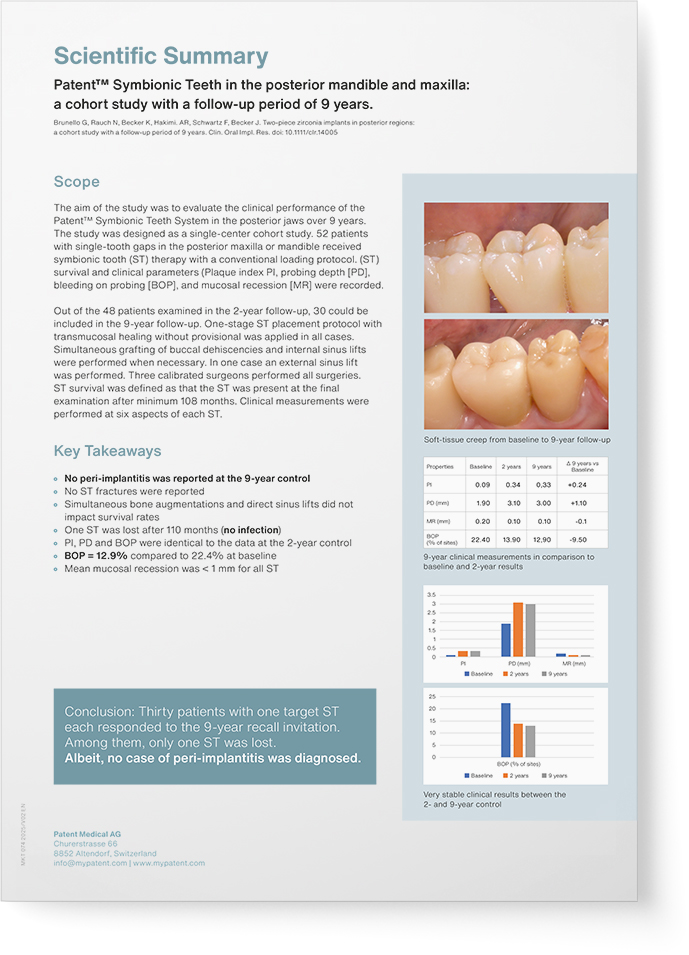 30 patients who received Patent™ Symbionic Teeth in the posterior region as single-tooth replacements were recalled after 9 years. No peri-implantitis was found, and mucosal recession remained exceptionally low. Instead of the deep pockets typically associated with dental implants (≥5 mm), all sites exhibited only shallow probing depths (≤3 mm) – comparable to those around healthy natural teeth.
30 patients who received Patent™ Symbionic Teeth in the posterior region as single-tooth replacements were recalled after 9 years. No peri-implantitis was found, and mucosal recession remained exceptionally low. Instead of the deep pockets typically associated with dental implants (≥5 mm), all sites exhibited only shallow probing depths (≤3 mm) – comparable to those around healthy natural teeth.
These findings demonstrate that it is possible to maintain stable esthetics of fixed tooth replacements over the long term.
- Mean mucosal recession: 0.1 mm (±0.2 mm)
- Mean probing depth: 3.0 mm (±0.6 mm)
- No peri-implantitis was reported
- Plaque index, bleeding on probing, and probing depth remained stable after 9 years
- Mean bleeding on probing: 12.9%
- No bleeding on probing in 55.2% of patients
PEER-REVIEWED COHORT STUDY
Follow-Up: 9 Years | Brunello et al., 2022 | Heinrich Heine University Düsseldorf | DOI: 10.1111/clr.14005
30 patients who received Patent™ Symbionic Teeth in the posterior region as single-tooth replacements were recalled after 9 years. No peri-implantitis was found, and mucosal recession remained exceptionally low. Instead of the deep pockets typically associated with dental implants (≥5 mm), all sites exhibited only shallow probing depths (≤3 mm) – comparable to those around healthy natural teeth.
These findings demonstrate that it is possible to maintain stable esthetics of fixed tooth replacements over the long term.
- Mean mucosal recession: 0.1 mm (±0.2 mm)
- Mean probing depth: 3.0 mm (±0.6 mm)
- No peri-implantitis was reported
- Plaque index, bleeding on probing, and probing depth remained stable after 9 years
- Mean bleeding on probing: 12.9%
- No bleeding on probing in 55.2% of patients
PEER-REVIEWED PROSPECTIVE STUDY
Follow-Up: 2 Years | Becker et al., 2015 | Heinrich Heine University Düsseldorf | DOI: 10.1111/clr.12610
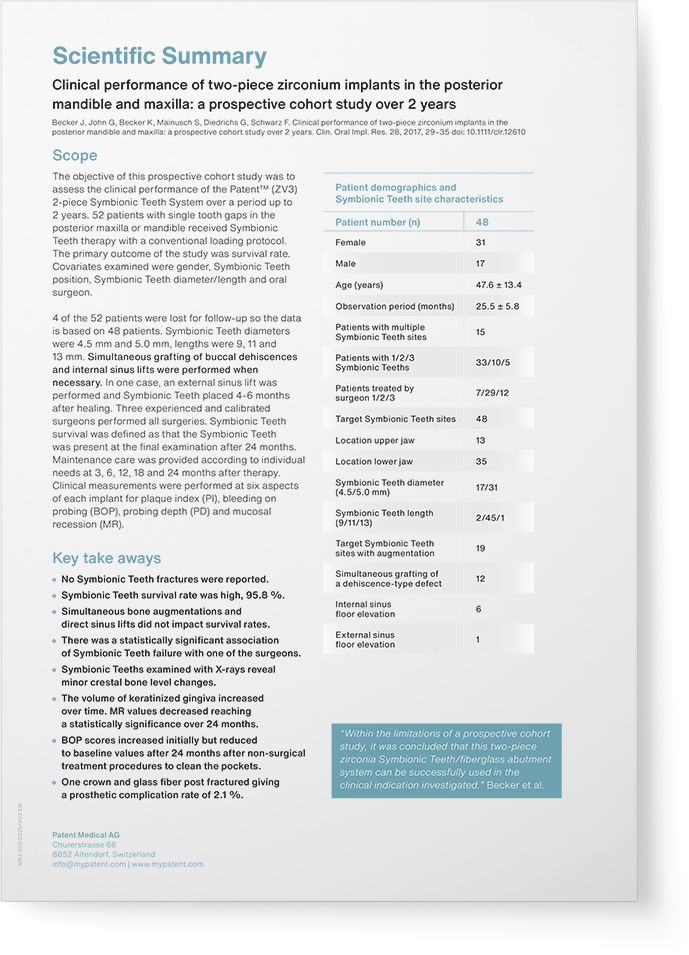 52 patients received Patent™ Symbionic Teeth in the posterior region as single-tooth restorations. Simultaneous bone grafting and sinus lifts were performed when needed, and a conventional loading protocol was applied. 48 of the patients could be recalled after 2 years to assess clinical parameters and determine the survival rate.
52 patients received Patent™ Symbionic Teeth in the posterior region as single-tooth restorations. Simultaneous bone grafting and sinus lifts were performed when needed, and a conventional loading protocol was applied. 48 of the patients could be recalled after 2 years to assess clinical parameters and determine the survival rate.
The results demonstrate that Patent™ provides reliable tooth replacement in the clinical indication investigated. Moreover, all symbionic teeth showed an increase in healthy keratinized mucosa, resulting in excellent esthetics.
- High survival rate of 95.8%
- Bone grafting/sinus lifts did not impact survival rates
- No fractures of symbionic teeth
- Volume of keratinized mucosa increased over time
PEER-REVIEWED COHORT STUDY
Follow-Up: 2 Years | Becker et al., 2015 | Heinrich Heine University Düsseldorf | DOI: 10.1111/clr.12610
52 patients received Patent™ Symbionic Teeth in the posterior region as single-tooth restorations. Simultaneous bone grafting and sinus lifts were performed when needed, and a conventional loading protocol was applied. 48 of the patients could be recalled after 2 years to assess clinical parameters and determine the survival rate.
The results demonstrate that Patent™ provides reliable tooth replacement in the clinical indication investigated. Moreover, all symbionic teeth showed an increase in healthy keratinized mucosa, resulting in excellent esthetics.
- High survival rate of 95.8%
- Bone grafting/sinus lifts did not impact survival rates
- No fractures of symbionic teeth
- Volume of keratinized mucosa increased over time
PEER-REVIEWED COHORT STUDY
Follow-Up: 5 to 12 Years | Karapataki et al., 2023 | Medical University of Graz | DOI: 10.11607/jomi.10284
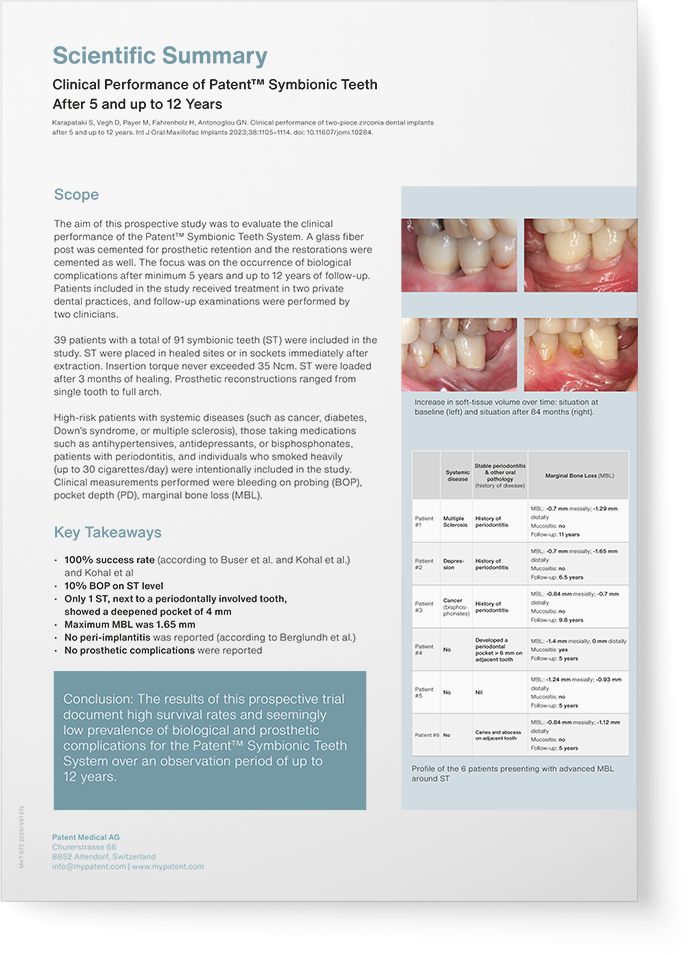 The patient cohort (39 patients with a total of 91 Patent™ Symbionic Teeth) was treated in two private dental practices and included individuals with risk factors (such as systemic disease, periodontitis, poor oral hygiene, or smoking) to reflect real-world clinical conditions.
The patient cohort (39 patients with a total of 91 Patent™ Symbionic Teeth) was treated in two private dental practices and included individuals with risk factors (such as systemic disease, periodontitis, poor oral hygiene, or smoking) to reflect real-world clinical conditions.
The study results demonstrate that Patent™ delivers predictable outcomes even in compromised patients who are frequently encountered in daily clinical practice but are typically excluded from tooth replacement surgery.
- No peri-implantitis (according to Berglundh et al.)
- 10% bleeding on probing
- No progressive bone loss
- Maximum marginal bone loss was 1.65 mm
- 100% success rate (according to Buser & Kohal et al.)
- Only 3 symbionic teeth showed mucositis; no pockets were detected around the other symbionic teeth
PEER-REVIEWED COHORT STUDY
Follow-Up: 5 to 12 Years | Karapataki et al., 2023 | Medical University of Graz | DOI: 10.11607/jomi.10284
The patient cohort (39 patients with a total of 91 Patent™ Symbionic Teeth) was treated in two private dental practices and included individuals with risk factors (such as systemic disease, periodontitis, poor oral hygiene, or smoking) to reflect real-world clinical conditions.
The study results demonstrate that Patent™ delivers predictable outcomes even in compromised patients who are frequently encountered in daily clinical practice but are typically excluded from tooth replacement surgery.
- No peri-implantitis (according to Berglundh et al.)
- 10% bleeding on probing
- No progressive bone loss
- Maximum marginal bone loss was 1.65 mm
- 100% success rate (according to Buser & Kohal et al.)
- Only 3 symbionic teeth showed mucositis; no pockets were detected around the other symbionic teeth
PEER-REVIEWED RETROSPECTIVE STUDY
Follow-Up: 3 Years | Brüll et al., 2014 | DOI: 10.11607/jomi.3293
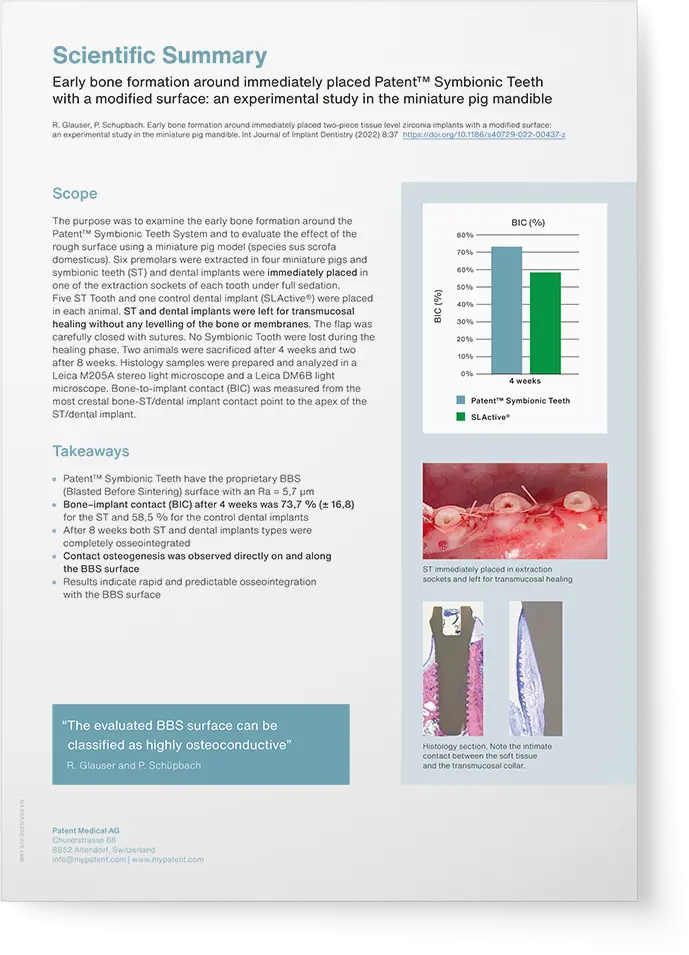
74 patients received a total of 121 Patent™ Symbionic Teeth in specialized dental practices and were recalled after 3 years. Marginal bone levels around the symbionic teeth remained stable or, in some cases, increased. Furthermore, they exhibited lower bleeding on probing and shallower pocket depths than the natural teeth.
The study results show that Patent™ Symbionic Teeth can maintain the stability and health of the surrounding hard and soft tissues, ensuring stable esthetics over time.
- High survival rate of 96.5%
- Mean probing depth: 1.8 mm (± 0.4 mm)
- Mean bleeding on probing: 4.1% (± 4.2%)
- Mean bone loss: 0.1 mm (± 0.6 mm)
PEER-REVIEWED RETROSPECTIVE STUDY
Follow-Up: 3 Years | Brüll et al., 2014 | DOI: 10.11607/jomi.3293
74 patients received a total of 121 Patent™ Symbionic Teeth in specialized dental practices and were recalled after 3 years. Marginal bone levels around the symbionic teeth remained stable or, in some cases, increased. Furthermore, they exhibited lower bleeding on probing and shallower pocket depths than the natural teeth.
The study results show that Patent™ Symbionic Teeth can maintain the stability and health of the surrounding hard and soft tissues, ensuring stable esthetics over time.
- High survival rate of 96.5%
- Mean probing depth: 1.8 mm (± 0.4 mm)
- Mean bleeding on probing: 4.1% (± 4.2%)
- Mean bone loss: 0.1 mm (± 0.6 mm)
FINITE ELEMENT ANALYSIS
Fiorillo et al., 2022 | University of Messina | DOI: 10.3390/prosthesis4030040
 This study aimed to evaluate the mechanical performance of Patent™ Symbionic Teeth by assessing stress distribution within both the symbionic tooth and the surrounding bone using finite element simulation.
This study aimed to evaluate the mechanical performance of Patent™ Symbionic Teeth by assessing stress distribution within both the symbionic tooth and the surrounding bone using finite element simulation.
The analysis revealed no risk of fracture in the glass fiber post, the connection between the symbionic tooth and post, or the symbionic tooth itself.
- Significantly lower compressive stress on the cortical bone when the symbionic tooth collar was positioned above it
- A higher positioning led to a more uniform distribution of occlusal load throughout the cancellous bone
- Deep placement resulted in high compressive loads on the cortical bone and low stress distribution within the cancellous bone
- Too deep placement should be avoided, as it can cause masticatory forces to generate stress on the surrounding bone
FINITE ELEMENT ANALYSIS
Fiorillo et al., 2022 | University of Messina | DOI: 10.3390/prosthesis4030040
This study aimed to evaluate the mechanical performance of Patent™ Symbionic Teeth by assessing stress distribution within both the symbionic tooth and the surrounding bone using finite element simulation.
The analysis revealed no risk of fracture in the glass fiber post, the connection between the symbionic tooth and post, or the symbionic tooth itself.
- Significantly lower compressive stress on the cortical bone when the symbionic tooth collar was positioned above it
- A higher positioning led to a more uniform distribution of occlusal load throughout the cancellous bone
- Deep placement resulted in high compressive loads on the cortical bone and low stress distribution within the cancellous bone
- Too deep placement should be avoided, as it can cause masticatory forces to generate stress on the surrounding bone
PRECLINICAL ANIMAL MODEL STUDY
Glauser & Schüpbach, 2022 | Zürich | DOI: 10.1186/s40729-022-00437-z
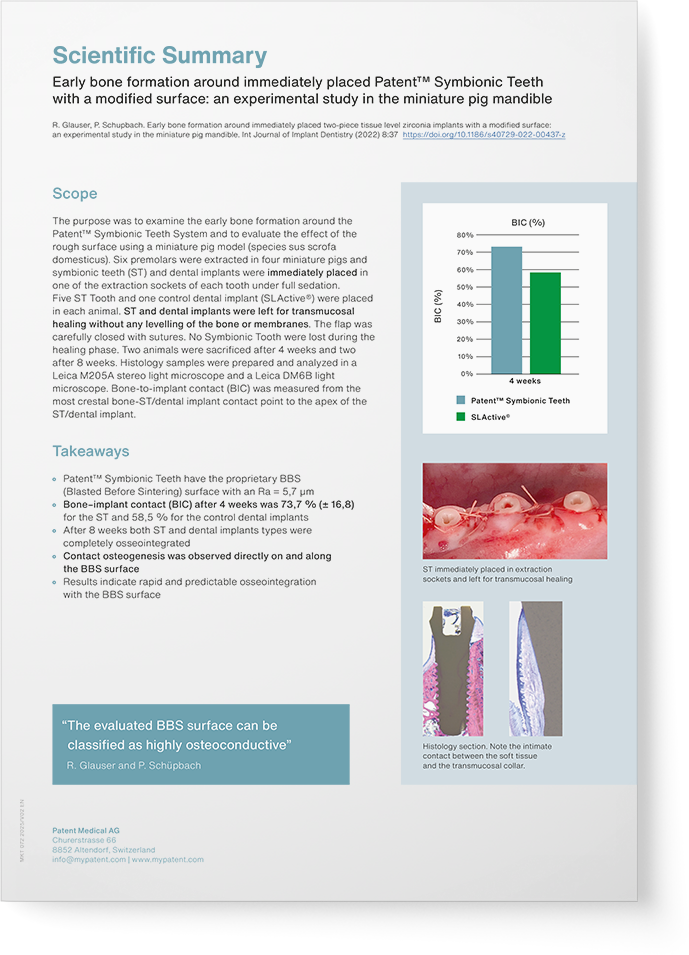
Patent™ Symbionic Teeth placed in the mandible of miniature pigs immediately after premolar extraction were evaluated histologically after 4 and 8 weeks of healing, with a focus on early bone formation.
With bone–implant contact (BIC) exceeding 70% after only 4 weeks of healing, Patent™ Symbionic Teeth outperform all dental implants investigated in similar studies regarding osseointegration speed.
- BIC after 4 weeks: 73.7% (± 16.8%)
- BIC after 8 weeks: 82.4% (± 16.9%)
- Very rough Patent™ surface contributes to rapid bone formation and osseointegration
- Despite nonexistent oral hygiene, only 1 site showed minor signs of inflammation
- Symbionic teeth showed firm soft-tissue adaptation
PRECLINICAL ANIMAL MODEL STUDY
Glauser & Schüpbach, 2022 | Zürich | DOI: 10.1186/s40729-022-00437-z
Patent™ Symbionic Teeth placed in the mandible of miniature pigs immediately after premolar extraction were evaluated histologically after 4 and 8 weeks of healing, with a focus on early bone formation.
With bone–implant contact (BIC) exceeding 70% after only 4 weeks of healing, Patent™ Symbionic Teeth outperform all dental implants investigated in similar studies regarding osseointegration speed.
- BIC after 4 weeks: 73.7% (± 16.8%)
- BIC after 8 weeks: 82.4% (± 16.9%)
- Very rough Patent™ surface contributes to rapid bone formation and osseointegration
- Despite nonexistent oral hygiene, only 1 site showed minor signs of inflammation
- Symbionic teeth showed firm soft-tissue adaptation